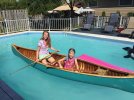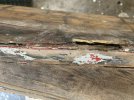BloomR
New Member
Hi folks. I am new to the forum although I have been browsing It for a couple or years in anticipation of getting going on some restoration projects. I have a couple of 1950’s era Chestnut and Peterborough 15 footers recently acquired and I hope to get going on them this summer. These will be my first restoration projects and I am hoping to get advice from folks here along the way.
I came across what I think is a Chestnut Bob’s special produced between 1950 to 1956. The canoe was being sold by the nephew of the original owner who bought it in Ottawa in the 50’s. Mostly stored indoors and seemed in decent shape. But there were signs that it had been recanvassed or at least repainted. The paint is now badly cracked and peeled. I first looked at the canoe 10 months ago and have read just about every post I can find on this forum to try to answer some questions resulting from the inspection. New canvas and hull inspection later this summer. In meantime there are some novel quirks in the construction of this canoe that might be appreciated by vintage canoe sleuths so here is the story:
-the boat is a Bob’s special based on my read of related threads here in the Forum (ghost image of original Chestnut deck decal, ribs (1/4” thickness), weight (<60 lbs), keel (beveled), caned seats etc.)
-there is a plate tacked to the upper side of the stern deck that provides a clue regarding age. The tag reads “Supplied by Blair Equipment Co. Ottawa, Canada”. I looked up the company and found records of it in Ottawa newspaper ads offering hardware sales and boat repair service in the early 1950’s until it apparently closed shop in 1956. I concluded that the shop was a retailer of Chestnut canoes and this was the point of origin. And since that period is reputed to be a time of good quality work at Chesnut, I bought the canoe last week.
- now that its home I noted the patina and styling of the interior has an “old“ feel to it. I have seen a lot of wooden boats from the 30s to 50’s (my father has refinished Muskoka boats for many years and having those wood boats around sort of gets into your DNA). I got wondering if maybe the boat was older and simply refinished by Blair Equipment and sold used with theit tag attached at that time.
Some things that make me wonder about that:
-all the outwale screws are Phillips! As are all the keel screws. Yet I found that some of the stem band screws were slot except for those above the waterline. Not a Robertson screw anywhere.
-keel screws in every rib which I believe I read is an older trait?
-the decks are nicely arched with the characteristic bevel underneath. They are heart shaped but for Bobs that seems to have very little correlation with age.
-the stem is original and doesn’t appear to be tapered
So after all that, my question is whether anyone has come across a vintage boat like this with so many Philips fasteners when it is almost certain to have no history in the US. Where Phillips would have been common.
If folks agree that the above all adds up to a 1950’s era build, maybe the serial number stamp is of interest to folks looking for a number with an estimated age (1950 to 1956). Serial number is “9218 15 EX”. Also odd to me that the serial number stamp is at the stern not the bow. Or is that typical.
Thanks for reading if you made it this far. I am sure to have questions about how to bring this pretty little canoe back into paddling condition.
I came across what I think is a Chestnut Bob’s special produced between 1950 to 1956. The canoe was being sold by the nephew of the original owner who bought it in Ottawa in the 50’s. Mostly stored indoors and seemed in decent shape. But there were signs that it had been recanvassed or at least repainted. The paint is now badly cracked and peeled. I first looked at the canoe 10 months ago and have read just about every post I can find on this forum to try to answer some questions resulting from the inspection. New canvas and hull inspection later this summer. In meantime there are some novel quirks in the construction of this canoe that might be appreciated by vintage canoe sleuths so here is the story:
-the boat is a Bob’s special based on my read of related threads here in the Forum (ghost image of original Chestnut deck decal, ribs (1/4” thickness), weight (<60 lbs), keel (beveled), caned seats etc.)
-there is a plate tacked to the upper side of the stern deck that provides a clue regarding age. The tag reads “Supplied by Blair Equipment Co. Ottawa, Canada”. I looked up the company and found records of it in Ottawa newspaper ads offering hardware sales and boat repair service in the early 1950’s until it apparently closed shop in 1956. I concluded that the shop was a retailer of Chestnut canoes and this was the point of origin. And since that period is reputed to be a time of good quality work at Chesnut, I bought the canoe last week.
- now that its home I noted the patina and styling of the interior has an “old“ feel to it. I have seen a lot of wooden boats from the 30s to 50’s (my father has refinished Muskoka boats for many years and having those wood boats around sort of gets into your DNA). I got wondering if maybe the boat was older and simply refinished by Blair Equipment and sold used with theit tag attached at that time.
Some things that make me wonder about that:
-all the outwale screws are Phillips! As are all the keel screws. Yet I found that some of the stem band screws were slot except for those above the waterline. Not a Robertson screw anywhere.
-keel screws in every rib which I believe I read is an older trait?
-the decks are nicely arched with the characteristic bevel underneath. They are heart shaped but for Bobs that seems to have very little correlation with age.
-the stem is original and doesn’t appear to be tapered
So after all that, my question is whether anyone has come across a vintage boat like this with so many Philips fasteners when it is almost certain to have no history in the US. Where Phillips would have been common.
If folks agree that the above all adds up to a 1950’s era build, maybe the serial number stamp is of interest to folks looking for a number with an estimated age (1950 to 1956). Serial number is “9218 15 EX”. Also odd to me that the serial number stamp is at the stern not the bow. Or is that typical.
Thanks for reading if you made it this far. I am sure to have questions about how to bring this pretty little canoe back into paddling condition.
Attachments
-
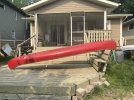 BB656375-5201-4AF8-8904-7C8AB8E32D46.jpeg272 KB · Views: 275
BB656375-5201-4AF8-8904-7C8AB8E32D46.jpeg272 KB · Views: 275 -
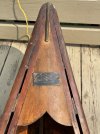 641353F4-16B5-47A8-B06A-9F33A0D49865.jpeg229.6 KB · Views: 270
641353F4-16B5-47A8-B06A-9F33A0D49865.jpeg229.6 KB · Views: 270 -
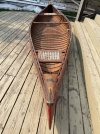 0A6E28D0-38F0-4518-B5A0-C6F09D67046F.jpeg323 KB · Views: 263
0A6E28D0-38F0-4518-B5A0-C6F09D67046F.jpeg323 KB · Views: 263 -
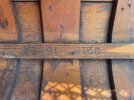 F15D509C-F0E2-4E03-B545-28ADBB071510.jpeg267.3 KB · Views: 261
F15D509C-F0E2-4E03-B545-28ADBB071510.jpeg267.3 KB · Views: 261 -
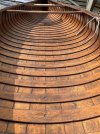 360EF06C-5462-499E-90A7-58E2A47EE594.jpeg312.8 KB · Views: 253
360EF06C-5462-499E-90A7-58E2A47EE594.jpeg312.8 KB · Views: 253 -
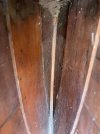 A04AEF14-1A1E-425D-91EA-0F02FDD176A9.jpeg175.8 KB · Views: 276
A04AEF14-1A1E-425D-91EA-0F02FDD176A9.jpeg175.8 KB · Views: 276 -
 123E5346-C9B9-4EE4-8BD2-EBAA46C54D6C.jpeg259 KB · Views: 271
123E5346-C9B9-4EE4-8BD2-EBAA46C54D6C.jpeg259 KB · Views: 271 -
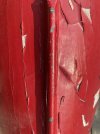 EBF50A2F-871C-41A6-9DC2-A8CB766C5E0F.jpeg166.9 KB · Views: 259
EBF50A2F-871C-41A6-9DC2-A8CB766C5E0F.jpeg166.9 KB · Views: 259 -
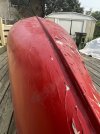 DD58B757-BA3E-4AB4-AD83-5F36CCFD1D72.jpeg248.7 KB · Views: 263
DD58B757-BA3E-4AB4-AD83-5F36CCFD1D72.jpeg248.7 KB · Views: 263
Last edited:


